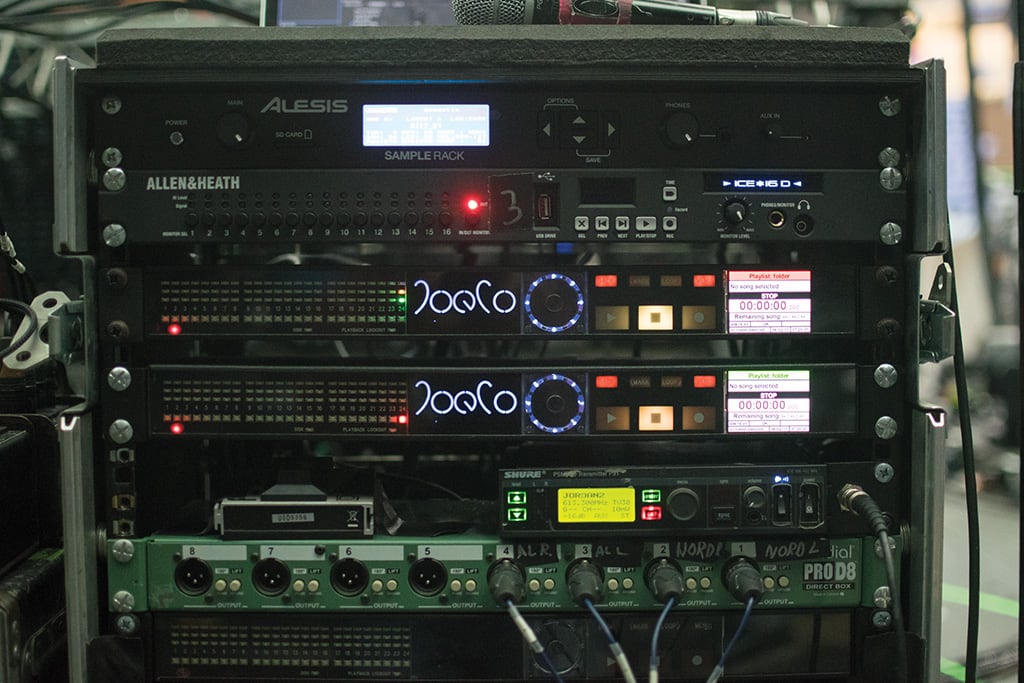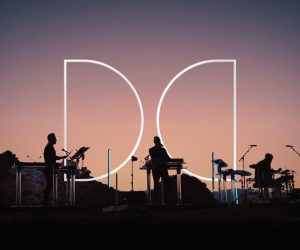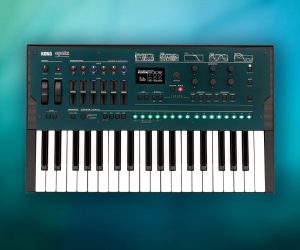
New Horizons
Bring Me The Horizon’s transition from Metal to Metalcore hasn’t stopped them being loud! Hutch explains how to mix when your hearing’s on the edge.
Show Photo: Jaz Meadows
It’s 9pm on a Monday night. I’m sitting in my car in Margaret Court Arena’s underground carpark listening to my mud flaps rattle. Sheffield metalcore rockers Bring Me The Horizon had just opened their set. The stage is at least 50m away — with lots of concrete between here and there — but I already know Hutch wasn’t kidding when he told me during soundcheck that he likes his subs loud.
Oliver Hutchinson — that’s Hutch — has been mixing BMTH for five years. That’s long enough to have surfed the band’s transition from metal to metalcore — a short ride for some, but all the difference in the world to others [see ‘Get to the Core’ box]. It’s also long enough to have each song’s fader moves printed to muscle memory. His affiliation with BMTH has taken him around the world. He would have even made it to Ukraine if not for a rocket launcher attack the week before.
Before his globe-trotting journey began, Hutch cut his live sound teeth mixing for a mate’s band in high school, then learnt the ropes of monitor engineering doing the pub gig circuit, followed by a sound technician role at a venue in Leeds. He came across Bring Me The Horizon quite by chance.
“It was only supposed to be a gig in Sheffield,” recalled Hutch. “To be honest I hadn’t heard of them at that point. I had a little listen and was like, ‘Whoa, sounds very heavy.’ Incidentally, that was Jordan Fish’s (keyboardist/programmer) first gig as well, so things changed sound-wise from that point. I was working with an indie band at the time. Most gigs were very pop rocky. I also did some ska bands, even though I’m not really a fan of ska. But mixing BMTH was fun. It’s diverse — the set list goes from very heavy to very chilled. It keeps you on your toes when you go between very distorted guitar parts and heavy drum patterns to chilled keys parts and vocals with reverb.”
THAT’S THE SPIRIT
BMTH’s latest album That’s The Spirit is notably more radio-friendly than their earlier tunes. When I raised the notion of recreating that slick sound at a live show Hutch responded with a funny look. “I try and hit all the hooks from the album so people can recognise the songs, but I definitely don’t try to recreate the album sound. I like to make use of the PA we’ve got — it’s not being played on an iPhone!”
That means dynamics. And lots of sub. To preserve the transient detail in the show while still milking every inch of punch from the PA, Hutch employs an unconventional technique. He leaves all channel strips completely bare and relies entirely on parallel group processing. Yep, you won’t find a single compressor on any of the direct input channels — the kick, snare, vocals, nothing.
Instead, parallel compression is the name of the gain reduction game. All input channels are grouped into VCAs, then sent to various parallel compression busses, most with fairly aggressive settings. Hutch says this allows him to beef up the sound without slicing away all the natural dynamics of the show.
“I use parallel compression for everything,” he said. “Everything’s really clean then just goes into groups so I can dynamically change the level of compression with buses rather than actually changing individual settings. It also allows me to go between the heavy songs and the softer songs without really changing many settings. I just change the balance between the different buses.”
This unique workflow is a carryover trait from Hutch’s analogue mixing days. Nothing teaches efficient use of processing like having just two Drawmer compressors to mix a whole show. Adopting bus processing from an early stage helped make the most of limited resources, and the fact that today’s digital consoles are capable of running copious amounts of DSP per-channel hasn’t changed his approach.
Though now a Digico SD user, Hutch is accustomed to mixing with third-party plug-ins from his Avid Profile days. Some of his favourites include the Waves CLA-76 on the drums bus, Waves API-2500 on guitars to smooth out the highs, and Waves C4 multi-band compressor on the output. “I only keep the high-mid band active on the C4, just to catch the horrible sharp spiky bits that might take people’s heads off. I reference it every now and then to make sure I’m not driving into it really. It’s just there as a safety net more than anything else.”
Effects are minimal, according to Hutch: “There’s a plate on the drums, a vocal doubler that barely sits underneath just to make Oli sound a bit bigger, and a hall reverb that gets used in about three songs. Those are all Digico effects, I’ve never really enjoyed Waves effects.”
I/O GALORE
For a metal show, the I/O is rather extensive. Much of that is due to the playback system handled by keyboardist Jordan Fish. Timecode is generated from the same rack that sits next to Jordan’s keyboards and percussion, and several key elements of the show are synced to it. Add stereo keys, stereo Akai MPK, stereo Alesis Sample Rack outputs, electronics from the drum kit, rack and floor tom triggers, talkback mics for all the crew, and the input count streaks up to 56.
On top of mixing FOH, Hutch also controls video playback for the mammoth LED videowall backdrop — though his job is rarely much more than the occasional fade and a quick strobe using the spacebar shortcut. Video is synced to the timecode and backline tech Jamie McKivitt uses a footswitch to kick off playback for each song, triggering the timecode, click, and all of Jordan’s programming and samples. It’s a tight, neat, and largely automated affair.
Mic setup is plain as vanilla. It’s predominantly Shure dynamics or condensers, with the odd Sennheiser e906 or MD421 on guitar cabs and an Audix D6 on kick. Hutch likes to keep things simple. An SM57 is far easier to replace on a global tour than a custom hand-wired boutique model that’s going to get thrashed every show anyway.
Lead singer Oliver Sykes uses a Shure wireless handheld. “We’ve gone through all sorts of different capsules but we’ve settled with the standard Beta58 now,” says Hutch. “He keeps throwing them on the floor so it sounds entirely different every day. We have a wired SM58 as an ultimate backup, which usually sounds amazing!”
A single guitar results in six channels — two mics on the clean cab, two on dirty, plus a DI from each. Occasionally Hutch mixes in the DI signal underneath the mics to add some clarity to more intricate passages, though he admits it sounds horrible by itself.

MONITOR PRIORITY
The BMTH chaps are all on IEMs. Aussie monitor engineer Jared Daly helms an Allen & Heath dLive to mix very specific cochlear concoctions for each member.
Having initially mixed monitors for the band, Hutch appreciates the importance of Daly’s role. “Jared’s very involved with everything. The band all like very different things and they’ve all got very different levels of hearing ability as well. The drummer was told he’s got a hearing age of an 82-year-old so his mix is just low end and reverb, super compressed. It’s all about feel. He’s got no top end response at all really. That’s why we have the china mic — it just really needs to cut through for him to hear it. The guitarist stage right has mainly himself. Oli has a mix like the CD with himself on top. Jordan has a very low and spaced mix with himself on top. He’s always the most particular about it.”
WIRELESS ORGANISER
A few RF nightmares led to the upgrade of their entire wireless rig to incorporate Shure’s Axient frequency management system. The band’s IEMs are the Shure PSM1000s, the crew is on PSM900s, and guitars on UR40s.
Because the band members take their in-ear mixes so seriously, Hutch is more than happy to play second fiddle to Jared’s demands for monitoring perfection. In fact a number of mics are set up for the sole purpose of giving individual band members a more comprehensive monitor mix — you won’t hear a peep from them out front. For example, the bass cab is miked up for Matt Kean’s monitor mix, but only the direct SansAmp DI signal is used in FOH.
But IEMs aren’t enough — BMTH still likes to have some stage level. Okay, a lot of stage level. d&b audiotechnik J12 sidefills flank either side of the stage, plus subs under the keyboard riser, going hard all show.
“The biggest problem is just the amount of noise coming off stage,” says Hutch. “Despite the in-ears the huge side fills are sometimes a little annoying… but it used to be worse. The last show I was doing over here Oli [Sykes] asked me, ‘Is it normal to get nauseous on stage?’ I said ‘No. It’s just the amount of level up there.’ It’s just too loud. I couldn’t walk on stage. I had earbuds in, hands over my ears, and I still couldn’t go on stage. I said ‘Dude, we’ve gotta stop doing this and get some in-ears.’ He tried it for a gig, hated it, then went back to it after a while. Still, the sidefills are running all show because Oli generally takes his ears out toward the end of the set, just to get a bit more vibe.”
Stage setup is clean. All amps and cabs are tucked away under the stage to give clear view of the massive LED wall silhouetting the band for the entire show. BMTH’s set is a visual feast that almost steals the glory. Hutch created the visuals for four songs anyway, so he doesn’t mind. When the touring life starts to feel old, he’s keen to spend more time on the visual aspect of shows.
“I’m assuming my hearing is going to get worse and worse so I’m trying to get more involved in the visual side of things, more production stuff. I’m still enjoying mixing at the moment and haven’t had any negative feedback so I assume I can still hear to a reasonable extent — though I won’t do this forever. I’d quite like to live at home for some period of my life, but it’s fun for now.”





















Good stuff!! Quick question, when you’re talking about their cabinets I got confused. Are you saying they pan each cabinet left and right or they pan each mic left and right so you have a clean and dirty on each side?